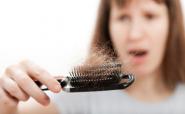Advertisement
Featured article
Hair loss in women
What causes it and how to fight back

As women age all kinds of unpleasant things happen. The body bloats, skin sags and loses pigment and hair begins to fall out beyond the norm. It is a cruel trick of Mother Nature. Luckily, in today’s world there is something that can be done about each of those issues if you know where to look. In this article we are going to focus on hair loss; what causes it and what we can do about it.
Everybody loses a certain amount of hair every single day. Anywhere from 50 to 100 strands of hair is considered within the “normal” zone. However, if hair loss begins to double, triple, or quadruple in number, then it is time to uncover what could be causing the problem.
Hair loss due to over-processing is common. Women do a lot of things to their hair; they perm it, color it, straighten or curl it with heat and they shampoo, shampoo, and shampoo. All of these things can cause damage to the hair when done alone - combined together they can do a real number on the healthiest head of hair.
article continuedAdvertisement
Some women shampoo their hair every day. Unless the hair is oily, that isn’t a good idea. Shampoo contains detergent that will strip the hair of all its natural oil; for some women, what it leaves behind is dry, brittle hair that is easy to break. Since aging hair is already fragile, adding too much shampoo into the equation can really result in major problems. Of course conditioner was invented to help replenish those oils and, for the most part it works - but only on a short term basis. The better option is to switch to a shampoo that is formulated specifically not to strip the hair, just to cleanse and condition it.
Shampoo is particularly bad for color-treated hair because it strips away the color more quickly. That often means that women re-color too often, resulting in yet more damage. It’s a vicious circle that can leave hair broken and beyond repair. Instead, they should switch to one of today’s new colorfast shampoos, which are formulated to help retain color by keeping the detergent from stripping it away.
Certain hair styles or methods of styling the hair can contribute to hair loss. For example wearing tight cornrows, pigtails, chignons, French twists or ponytails that severely pull and stress the scalp can cause what is known as traction alopecia. If those styles are continued it can result in scalp scarring, which may result in permanent hair loss.
Using chemicals in the hair, as for example during color treatments, permanents, or simple hot oil treatments, may result in scalp inflammation, which can also result in irreversible hair loss. The application of heat to curl or straighten the hair is another major culprit because it dries the hair shaft causing it to become brittle and break.
However, what a woman does to her hair isn’t the only cause behind hair loss. Other things can add to the equation, one of them being hormone changes. When a woman’s hormones spike or drop, hair loss is a common side effect; women often experience the problem during pregnancy and menopause as well as during any other artificial hormonal change environment like chemotherapy or radiation. For many, hair will regrow once the hormone issue is solved. For a few, thinning or balding may become a permanent state of affairs.
Certain types of medications can cause hair loss as well. The most common culprits are blood thinners, high blood pressure medicines, drugs used to treat heart disease, and antidepressants. For some, birth control pills can result in hair loss due to the hormone factor. For others, taking too many or the wrong kind of vitamins can hurry along the problem. Too much vitamin A in particular is something to watch out for.
Illnesses can lead to hair loss, particularly those related to the scalp like fungal infections. Others include conditions such as diabetes and lupus. Sometimes hair loss is a side effect of a surgical procedure. The good news is that once the conditions are controlled, hair often begins growing once again. For a sad few, certain types of alopecia or common baldness will occur, resulting in permanent hair loss.
Even the mere act of life may cause hair loss for some. That is because of daily stress and not taking the time to eat properly or exercise. In such instances, correcting the underlying problem may also correct hair loss.
There are no easy answers to what causes hair loss. Discovering its underlying cause can be frustrating and depressing. However, perhaps knowing where to begin to look is a step in the right direction to solving the problem.
Related Articles:
Got something to say?
We are looking for authors! Submit an article.
Related articles
Laser, light and heat hair removal methods
A look at alternatives to electrolysis and waxing
Hair care products you can make in your own kitchen
Why pay when home-made hair care is cheaper and better?
Review: InStyler Rotating Hot Iron Hair Straightener
A combination curling and flat iron that promises much
Top Stories
Get more from your makeup
Get extra value from your makeup with these tips
Versatile beauty products for the multi-tasking modern woman
A selection of two- and three-in-one beauty products
Foam hair colors - do they work?
Find out if foam hair colors are worth the extra money
Comments
Add your comment